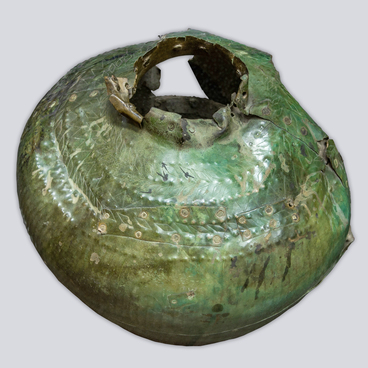The epaulet-like buckle on display consists of a trapezoidal plate and an umbo, i.e. a hemispherical boss badge. They are connected by means of six metal pins with diagonal notching.
Epaulet-like buckle
Время создания
1st century BC – 1st century AD
Размер
10x17 cm
17.65х10х2.4 cm
17.65х10х2.4 cm
Техника
forging, casting based on a wax model
Выставка
0
Открыть в приложении#1
Epaulet-like buckle
#9
#10
The technique used for making such accessories was rather complicated. Thin pins were folded in a metal sheet and, for further connection, they were put into a mould block for casting the front plate with a hook. The umbo was made separately and soldered to the other end of the item.
#11
Scientists refer such buckle to the Pyany Bor culture. For the first time, it was described by archaeologist Alexander Spitsyn on the basis of artefacts found in the late 19th century during excavations at the burial site near the village of Pyany Bor (currently known as Krasny Bor) in the Republic of Tatarstan. Most specialists believe that the Pyany Bor culture was present in the period from the middle of the 2nd century BC till the early 3rd century AD on the territory of the Middle and Lower Kama regions.
In the Middle Kama regions, archeologists have discovered remains of houses, household items and funeral attributes of ancient population inhabiting these lands. Specialists have established that Pyany Bor people used to settle on two types of sites: small refuge fortresses on the outskirts of their inhabited areas or major settlements in central regions. Their main activities were cattle breeding and hoe farming, as well as hunting, fishing and wild-hive beekeeping. Pyany Bor population lived in large patriarchal-style families. Members of such families did common housekeeping and buried the deceased relatives in one place.
#12
The most numerous portion of discovered artefacts is made of decorations and garment details. Funeral clothes were decorated in the same way as commonly used ones. Therefore, archeologist Vladimir Genning established that epaulet-like buckles were most likely used as buckles for women’s waist belts.
#8
Apart from quite scarce tools of trade, archeologists have also discovered certain arms used by Pyany Bor population: those were mainly swords and arrow heads. Burial sites also contained Egyptian figures in the shape of lions and scarabs, Bosporan metal fibula clasps, and Sarmatian mirrors made of bronze. These artefacts serve as evidence to the fact that Pyany Bor had dynamic trade relations with various tribes and peoples.
#13
National Museum of the Republic of Tatarstan
читать дальшескрыть
00:00
00:00
1x
Epaulet-like buckle
Время создания
1st century BC – 1st century AD
Размер
10x17 cm
17.65х10х2.4 cm
17.65х10х2.4 cm
Техника
forging, casting based on a wax model
Выставка
0
Открыть в приложении
Поделиться



